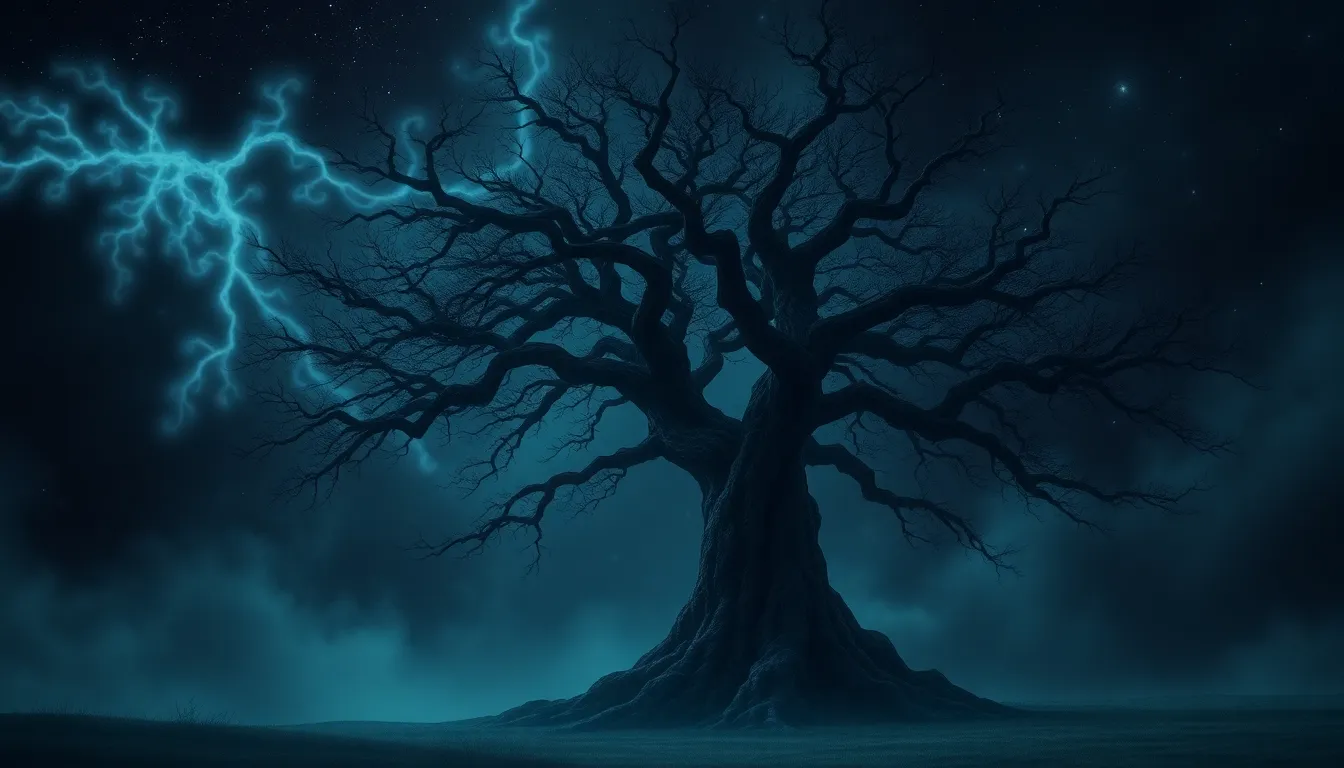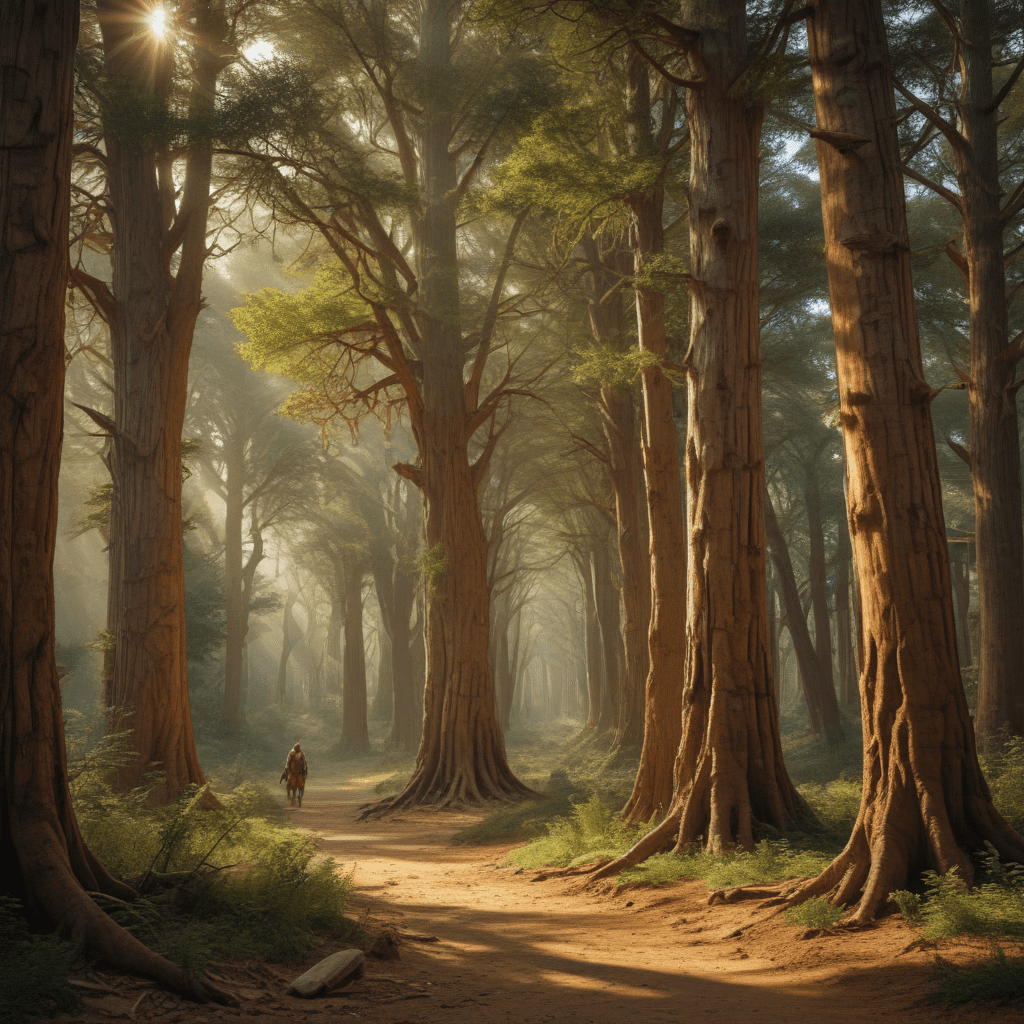The Tree of the Night: Myths of Darkness and Light
I. Introduction
Trees have long held a metaphorical significance in cultures around the world, often representing life, growth, and the interconnectedness of all beings. They stand as monuments of nature, with roots that dig deep into the earth and branches that reach toward the heavens. Among these symbols, the concept of the Tree of the Night emerges as a compelling figure representing duality—the coexistence of darkness and light.
This article will explore the rich tapestry of myths surrounding the Tree of the Night, examining its role as a symbol of darkness, its contrasts with the Tree of Life, and its significance in various cultures. We will delve into the psychological implications of these myths and their contemporary interpretations in literature and popular culture.
II. The Symbolism of Trees in Mythology
Trees play a pivotal role in various creation myths, often depicted as life-givers that nourish and sustain life. They are seen as sacred entities, bridging the earth and the sky, embodying the essence of growth and regeneration.
A. Trees as life-givers and their role in creation myths
- In many cultures, the first humans were created from the wood of a sacred tree.
- Various myths depict trees as the source of water, food, and shelter, vital for survival.
B. The duality of trees: representing life (light) and death (darkness)
While trees symbolize life, they also embody the inevitability of death. Their cycles of growth and decay reflect the natural order and the balance of existence.
C. Cultural variations in tree symbolism
Different cultures attribute unique meanings to trees. For instance:
- In Norse mythology, Yggdrasil, the World Tree, connects the nine realms, embodying life and death.
- The Bodhi tree in Buddhism symbolizes enlightenment and the cessation of suffering.
III. The Tree of Life vs. The Tree of the Night
The Tree of Life is often depicted as a vibrant symbol of growth, prosperity, and the interconnectedness of all living beings, while the Tree of the Night represents the unknown, the fears, and the shadows lurking in the depths of existence.
A. Definitions and characteristics of the Tree of Life
- A symbol of fertility, rebirth, and immortality.
- Often associated with positive attributes such as health and abundance.
B. Exploring the concept of the Tree of the Night
The Tree of the Night stands as a metaphor for the darker aspects of life. It serves as a reminder of the fears and uncertainties that accompany existence, often linked to themes of loss and despair.
C. Comparative analysis of the two trees in different mythologies
In many mythologies, the Tree of Life and the Tree of the Night coexist, symbolizing the balance between joy and sorrow, light and darkness. For example:
- In Christianity, the Tree of Life is present in the Garden of Eden, while the Tree of Knowledge reflects the darker consequences of seeking forbidden knowledge.
- In Hinduism, the dualities of creation and destruction are represented in the forms of various deities associated with trees.
IV. Myths of Darkness: The Tree of the Night in Various Cultures
The Tree of the Night appears in various cultural narratives, often steeped in symbolism that reflects societal fears and the mysteries of the unknown.
A. European folklore and the significance of the darkened tree
In European folklore, dark trees often symbolize danger, the supernatural, or the presence of malevolent spirits. The ancient oak, for example, is sometimes seen as a portal to the underworld.
B. Indigenous myths focusing on night and darkness
Indigenous cultures frequently incorporate the Tree of the Night in their myths, viewing it as a sacred entity that embodies the spirit world. These trees are often believed to hold the souls of ancestors or serve as guides during spiritual journeys.
C. Asian interpretations of the Tree of the Night
In Asian cultures, the Tree of the Night may represent the balance of yin and yang, embodying the duality of existence. For instance:
- In Chinese mythology, certain trees are associated with the moon, symbolizing femininity and introspection.
- In Japanese folklore, night-blooming flowers are often linked to the spirit world and the transient nature of life.
V. Myths of Light: The Counterbalance to Darkness
Light plays a crucial role in mythology, often serving as a symbol of hope, guidance, and rebirth. The interplay between light and darkness is a recurring theme across cultures.
A. The role of light in mythology and its relationship with darkness
Light is frequently portrayed as a force that dispels darkness, representing knowledge, purity, and divinity. Myths often depict heroes and deities overcoming darkness through their light.
B. Stories of hope and rebirth associated with the Tree of Life
The Tree of Life is often associated with stories of renewal, such as:
- The myth of Persephone, where her return to the earth signifies the rebirth of nature.
- The cyclical nature of seasons, where the Tree of Life flourishes in spring after the darkness of winter.
C. The interplay between light and dark in various myths
Many myths highlight the necessity of both light and dark, emphasizing that one cannot exist without the other. This duality is essential for understanding the human experience.
VI. The Psychological Aspects of Darkness and Light
The symbolism of night and day resonates deeply within the human psyche, representing our fears, hopes, and the eternal struggle between opposing forces.
A. The human psyche and the symbolism of night and day
Night often evokes feelings of fear and uncertainty, while day symbolizes clarity and safety. This dichotomy influences our emotions and perceptions of reality.
B. Exploration of fears and hopes embodied in the Tree of the Night and the Tree of Life
The Tree of the Night embodies our fears, such as the fear of the unknown, while the Tree of Life represents our hopes for growth, fulfillment, and connection.
C. The role of mythology in coping with darkness
Myths provide frameworks for understanding our experiences with darkness, offering narratives that help us cope with fear and uncertainty. They serve as guides in our journey through life.
VII. Contemporary Interpretations of the Tree of the Night
In modern literature and art, the Tree of the Night continues to evolve, reflecting contemporary themes and spiritual beliefs.
A. The Tree of the Night in modern literature and art
Contemporary authors and artists often use the Tree of the Night to explore themes of identity, trauma, and the human experience in a complex world.
B. Influence on contemporary spirituality and belief systems
The Tree of the Night has found resonance in various spiritual practices, symbolizing the journey through darkness toward enlightenment.
C. The tree as a symbol in environmental discussions and activism
As environmental issues become increasingly pressing, the Tree of the Night serves as a powerful symbol in discussions about nature, sustainability, and the importance of preserving our planet.
VIII. The Tree of the Night in Popular Culture
The Tree of the Night has made its way into popular culture, influencing narratives in movies, books, and music.
A. Analysis of the Tree of the Night in movies, books, and music
Films and literature often portray the Tree of the Night as a central figure representing struggle, transformation, and the journey through adversity. Examples include:
- In fantasy novels, the Tree of the Night often serves as a backdrop for epic battles between good and evil.
- In music, artists explore themes of darkness and light, using the tree as a metaphor for personal growth.
B. How modern narratives reshape traditional myths
Modern interpretations of the Tree of the Night often challenge traditional narratives, offering fresh perspectives on its symbolism and relevance in contemporary society.
C. The impact of these representations on societal views of darkness and light
As these narratives



